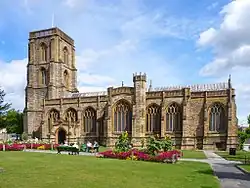Church of St John the Baptist, Yeovil
The Church of St John the Baptist in Yeovil, Somerset, is a Church of England parish church.
| Church of St John the Baptist | |
|---|---|
 | |
| Location | BA20 1HE, Yeovil, Somerset, England |
| Coordinates | 50°56′30″N 2°37′53″W |
| Built | Late 14th century |
Listed Building – Grade I | |
| Designated | 19 March 1951[1] |
| Reference no. | 261341 |
 Location of Church of St John the Baptist in Somerset | |
The church was built between 1380 and 1405, but was renovated in the 1850s. It has been designated as a Grade I listed building.[1] The tower, which was built around 1480,[2] is 92 feet (28 m) high, in four stages with set-back offset corner buttresses. It is thought that the work was supervised by William Wynford, master mason of Wells Cathedral.[1] To meet the growing size of Yeovil and the increased population, work on a second church, Holy Trinity, began on 24 June 1843,[3] and this relieved the pressures on St John's. In 1863, shortage of space in the graveyard was alleviated by the opening of the Preston Road cemetery.
The church is capped by openwork balustrading matching the parapets which are from the 17th century. Major reconstruction work was undertaken from 1851 to 1860. The tower has two-light late 14th century windows on all sides at bell-ringing and bell-chamber levels, the latter having fine pierced stonework grilles. There is a stair turret to the north-west corner, with a weather vane termination.[1] Among the fourteen bells are two dating from 1728 and made by Thomas Bilbie of the Bilbie family in Chew Stoke.[4] Another from the same date, the "Great Bell", was recast in 2013,[4] from 4,502 pounds (2,042 kg; 321.6 st) to 4,992 lb (2,264 kg; 356.6 st).[5]
Because of the state of some of the external masonry the church has been added to the Heritage at Risk Register.[6]

Unusually, the stained glass windows include a depiction of a lone Judas Iscariot with a dark halo.[7] Inside the church is a brass reading desk originally made in East Anglia.[8]
The parish is part of a benefice with St Andrew, Yeovil, in the Diocese of Bath and Wells.[9] A Member of the South West Gospel Partnership, it has an evangelical character.[10]
The Chantry

In 1573, the Chantry of St Mary the Virgin in the churchyard of the parish church was fitted out as a schoolroom by the parish. This developed into a charity school. In 1855, the schoolroom was demolished and replaced by a new building next to the churchyard, also called the Chantry,[11] which had feoffees who appointed a schoolmaster.[12][13] When the old schoolroom was demolished, it was estimated to date from the reign of Richard III, and some of its features, including two chimneypieces, were salvaged and built into the new Chantry, while the roof structure was copied.[11] By stages, the charity school morphed into Yeovil Grammar School, which closed in 1907 with the retirement of its schoolmaster.[14]
See also
References
- "Church of St John The Baptist". Listed Buildings Online. English Heritage. Retrieved 5 December 2010.
- Poyntz Wright, Peter (1981). The Parish Church Towers of Somerset, Their construction, craftsmanship and chronology 1350 - 1550. Avebury Publishing Company. ISBN 0-86127-502-0.
- "St John the Baptist Church". Yeovil History. Archived from the original on 4 March 2016. Retrieved 10 February 2016.
- "Yeovil, S John Bapt". Dove's Guide for Church Bell Ringers. Retrieved 25 December 2017.
- Moore, James; Rice, Roy; Hucker, Ernest (1995). Bilbie and the Chew Valley clock makers. The authors. ISBN 0-9526702-0-8.
- "Church of St John the Baptist, Church Path, Yeovil — South Somerset". Heritage at Risk. English Heritage. Archived from the original on 22 October 2013. Retrieved 19 October 2013.
- "The Church of St John Baptist". Yeovil History. Retrieved 8 October 2015.
- Dunning, Robert (1996). Fifty Somerset Churches. Somerset Books. pp. 54–58. ISBN 978-0861833092.
- "St John the Baptist, Yeovil". A Church Near You. Church of England. Retrieved 10 February 2016.
- South West Gospel Partnership: churches, swgp.org.uk
- Daniel Vickery, A Sketch of the Town of Yeovil (1856), pp. 35–40
- "Yeovil — Free School", in Schools Inquiry Commission, vol. XIV (1868), pp. 243–247
- Ordnance Survey, "Somerset LXXXIII.13" (surveyed 1886, published 1889), see "Grammar School, School (Girls & Infts)" immediately to the west of "St. John the Baptist’s Ch."
- L. C. Hayward, THE YEOVIL CHARITY SCHOOL – (PART 3 OF 3) in Chronicle: Yeovil Archaeological and Local History Society, April 1987, pp. 134-136